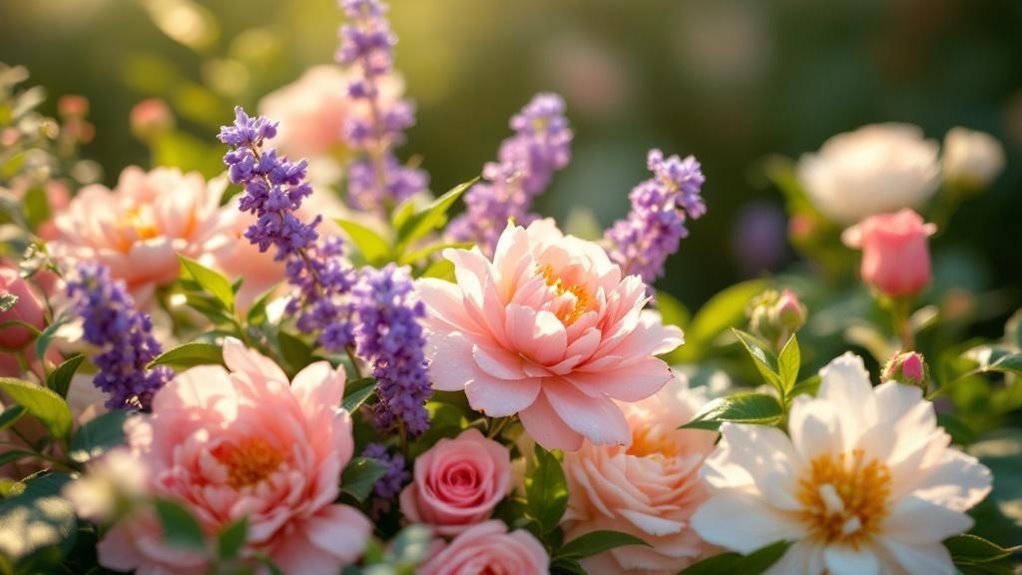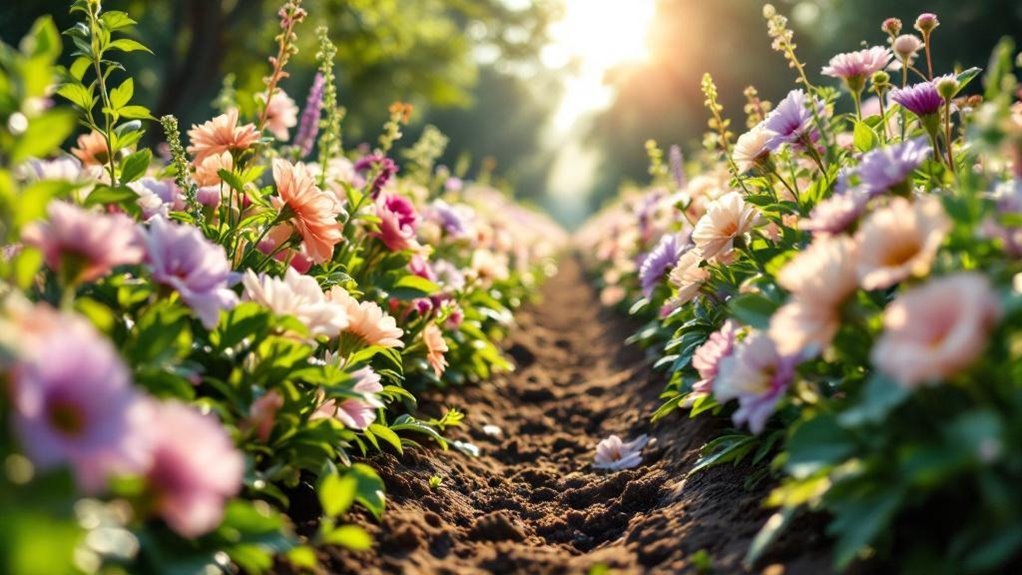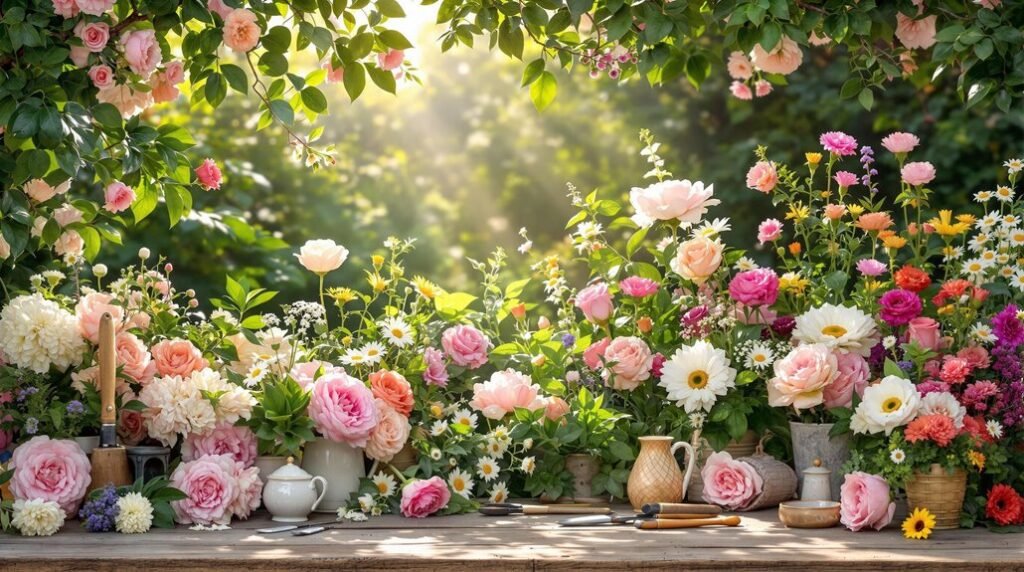Growing your own wedding flowers can transform your big day with blooms that tell your unique story. It’s more than just a budget-friendly choice—it’s about creating something personal and meaningful. But to get those perfect bouquets, you’ll need to understand the timing, flower varieties, and care involved. Before you dig in, consider what it takes to nurture a garden that blooms just right when you need it most.
The Motivation Behind Growing Your Own Wedding Flowers
Although traditional wedding flowers can be stunning, growing your own lets you create arrangements that truly reflect your style while saving a significant amount of money.
When you choose DIY wedding flowers, you get to personalize every bloom, making your wedding bouquets uniquely yours. Growing your own wedding flowers also offers a rewarding experience, as you nurture each plant leading up to your special day.
Personalize every bloom and enjoy the rewarding journey of nurturing your own wedding flowers.
By selecting blooms that thrive in your wedding season, you guarantee fresh, vibrant flowers that complement your celebration perfectly.
Plus, incorporating home-grown flowers supports a sustainable wedding by reducing your carbon footprint and promoting local ecosystems. Embracing this approach not only adds charm but also aligns your big day with eco-friendly values.
Planning Your Wedding Flower Garden
When you plan your wedding flower garden at least a year in advance, you give yourself the best chance to have blooms that peak right on your special day.
Start by considering your wedding date and local growing season carefully. Dedicate space to planting flowers—either in a garden patch or containers—to grow enough flowers for all your floral needs.
Choose easy-to-grow annuals like zinnias and cosmos to guarantee vibrant colors and a continuous bloom.
Keep these tips in mind:
- Succession planting every two weeks for a steady supply of flowers
- Select varieties suited to your climate and hardiness zone
- Have a backup plan with local flower farms or neighbors in case of setbacks
This way, your wedding bouquets will flourish beautifully.
Selecting the Best Flowers for Bouquets

Since your wedding bouquet needs to stay fresh and beautiful all day, you should choose flowers with a long vase life and sturdy petals.
Opt for cut flowers like roses, dahlias, and zinnias—these annual flowers hold up well and add vibrant color.
When selecting flowers for a wedding, choose varieties that thrive locally to guarantee freshness and ease of growth.
Incorporate a mix of focal blooms, secondary flowers, and fillers to create depth and texture; for example, pair large dahlias with smaller cosmos and eucalyptus greenery.
Don’t forget to include fragrant herbs like lavender or mint for added scent.
Understanding Bloom Times and Seasonality
To create a stunning DIY wedding bouquet, you need to understand bloom times and seasonality so you can pick flowers that will be at their peak on your big day.
Different seasonal flowers bloom at distinct times; for example, spring favorites like tulips bloom March to May, while summer dahlias flourish from July to September.
When growing flowers, succession planting is key—it lets you sow seeds in intervals to enjoy a continuous bloom leading up to your wedding.
If you’re working with a flower farm or your garden, knowing your hardiness zone guarantees you select the right varieties for your date.
Remember to plan backups since bloom times can vary with weather.
- Choose seasonal flowers based on your wedding month
- Use succession planting to extend bloom times
- Know your local growing conditions for best results
Preparing and Planting Your Flower Beds

Choosing the right spot for your wedding flowers is crucial—you’ll want a sunny, accessible area that makes planting and harvesting easy.
Start preparing your flower beds by creating raised beds with well-drained soil to promote healthy growth, especially for tuberous plants like dahlias.
Create raised beds with well-drained soil to ensure healthy growth for tuberous flowers like dahlias.
When planting, select a mix of easy-to-grow annuals and perennials that bloom during your wedding season, such as zinnias, cosmos, and hydrangeas.
Use succession planting to stagger bloom times, ensuring your wedding flowers are available continuously leading up to the big day.
Keep an eye on local frost dates to time your planting perfectly, typically putting tubers in the ground after the last frost.
Properly preparing and planting your flower beds sets you up for success when arranging flowers for your wedding bouquets.
Caring for Your Wedding Flowers
Once your flower beds are planted, giving your wedding flowers the right care will keep them healthy and vibrant.
Focus on providing consistent moisture by checking soil regularly and watering deeply during dry spells. About a month before the wedding, apply a balanced fertilizer to boost growth and blooms.
Mulching helps retain moisture and control weeds, especially in hot weather. Don’t forget deadheading spent blooms to encourage continuous flowering and maintain a lively display.
Here’s what you should do:
- Monitor soil moisture and water deeply as needed.
- Apply balanced fertilizer a month before your big day.
- Regularly deadhead to promote more blooms.
These steps guarantee your wedding flowers stay lush and ready for your special occasion.
Harvesting Flowers for Optimal Freshness
Although harvesting wedding flowers can feel time-sensitive, picking them early in the morning when temperatures are cooler helps you capture their peak freshness and moisture.
When harvesting flowers from flowering shrubs or cut flower beds, cut stems at a 45-degree angle to improve water uptake. Be sure to remove any leaves that would sit below the waterline to prevent bacterial growth.
To make a bridal bouquet that lasts, choose blooms at their peak stage, displaying vibrant colors and full shapes for best freshness.
Select vibrant, fully shaped blooms at peak freshness for bridal bouquets that endure beautifully.
Once cut, place your flowers immediately in water and store them in a cool, dark spot until you’re ready to arrange. These steps guarantee your wedding flowers stay hydrated and fresh, giving your bouquets a lasting, beautiful appearance.
Arranging Flowers for Bouquets and Decorations
After harvesting your flowers at their freshest, arranging them thoughtfully will bring your wedding bouquets and decorations to life.
When growing and arranging your own blooms, remember to select flowers and foliage with similar water needs for a lasting bridal bouquet. Mixing textures and heights adds depth—think tall delphiniums paired with shorter daisies. Don’t forget foliage like eucalyptus for fullness and fragrance.
Here are some tips for growing and arranging:
- Practice your arrangements ahead of time to perfect your vision.
- Choose colors that complement your wedding palette for cohesion.
- Visit your local farmers market for inspiration and seasonal blooms.
These strategies guarantee your flowers look vibrant and fit seamlessly into your wedding’s aesthetic.
Managing Challenges and Backup Plans
When growing your own wedding flowers, you’ll want to plan for unexpected setbacks like crop failures or bad weather by lining up local flower farmers or suppliers as backups. To grow a reliable supply, plant varieties with staggered bloom times and monitor for pests and diseases regularly. Use protective covers during extreme weather and keep a garden journal to track progress. Here’s a simple checklist to manage challenges and develop a backup plan:
| Challenge | Action | Backup Plan |
|---|---|---|
| Crop failure | Plant diverse flower types | Contact local flower farms |
| Pests and diseases | Regularly inspect plants | Use organic treatments |
| Weather extremes | Use row covers/hoops | Have supplier blooms on standby |
| Bloom timing issues | Record bloom dates | Adjust planting schedule yearly |
This approach guarantees your wedding flowers stay beautiful no matter what.
Collaborating With Friends and Family for Floral Support
Since wedding flowers carry special meaning, involving friends and family in growing and gathering blooms adds a personal touch while easing your workload. You can create a vibrant mix of garden flowers by inviting people to help contribute from their own gardens, making your floral support truly unique for your special day.
Involving loved ones in growing and gathering wedding flowers adds meaningful, personal beauty to your special day.
Organizing flower-gathering days turns harvesting into a fun group activity, ensuring you have enough blooms. To keep things smooth, assign clear roles like arranging flowers or managing logistics.
- Coordinate via a shared online document or group chat to track flower types and bloom times.
- Host a floral arrangement workshop to build skills and confidence together.
- Encourage contributions of garden flowers to diversify your bouquet.
This collaboration makes your bouquet meaningful and stress-free.
Frequently Asked Questions
Is It Possible to Grow Your Own Wedding Flowers?
You can definitely grow your own wedding flowers! With careful planning, selecting easy-to-grow blooms, and starting early, you’ll save money and create personalized bouquets that bloom beautifully on your special day.
What Flowers to Grow for Wedding Bouquets?
You’ll want to cultivate nature’s gentle whispers—dahlias, zinnias, and cosmos—for vibrant charm. Peonies add elegance, sweet peas and lavender bring fragrance, while eucalyptus and dusty miller offer lush texture, creating a bouquet that truly sings.
How to Regrow Flowers From a Bouquet?
To regrow flowers from a bouquet, you’ll remove foliage below water, take stem cuttings from rootable flowers like geraniums, or save seeds from blooms like daisies. Not all flowers regrow, so research your specific types.
How to Plant a Bridal Bouquet Plant?
Imagine your wedding bouquet blooming from your own hands. You’ll plant seeds or tubers in sunny, well-drained soil, water regularly, and nurture them until vibrant flowers fill your special day with natural beauty and love.
Final Thoughts
You might worry that growing your own wedding flowers feels overwhelming, but with a little planning and patience, it’s totally doable—and incredibly rewarding. By choosing easy-to-grow blooms and involving friends or family, you’ll create beautiful, fresh bouquets that truly reflect your journey together. Plus, the memories you make along the way are priceless. So, start early, stay organized, and enjoy the special touch only homegrown flowers can bring to your big day!
